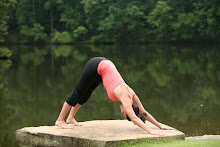I read this article in Yoga Journal and it made me want to share it. We all strive for happiness in life, so we can all take away something from this article.
What is your soul's true desire?
Uncover your personal blueprint for happiness and let it guide you to bliss...
Happiness. We all seek it. There is no more basic or universal drive than the desire to be happy. It is inherent, something we are compelled to want by virtue of who and what we are. Everything that human beings have accomplished and aspired to, our every endeavor, has been and always will be rooted in the impulse to satisfy our longing for happiness. We desire love, pleasure, beauty, friendship, accomplishment, wisdom, and power. Each of us longs for an abiding sense of purpose and meaning, peace, health, and security. At some level, we also aspire to freedom, to a greater capacity to shape our destiny, and to a connection with something greater than ourselves, which some call Source, Self, or God.
As the 13th-century poet Rumi observed: "The wings of humankind is its aspiration." Aspiration was responsible for the creation of language, society, culture, science, architecture, the world's spiritual traditions, and even walking on the moon. Everything that humanity has accomplished is the legacy of its enduring desire for fulfillment.
The yoga tradition provides one of humankind's most effective systems for achieving happiness in every aspect of life. In the same way that the physical practice of yoga so effectively benefits your body and mind, the larger science of yoga is similarly powerful in unlocking the vast potential of your body, mind, and spirit to help you achieve your best life imaginable. Yoga's supreme objective is to awaken an exalted state of spiritual realization, yet the tradition also recognizes that this state does not exist in isolation from the world and worldly matters. Thus, the science of yoga teaches you how to live and how to shape your life with a commanding sense of purpose, capacity and meaning. In short, yoga has less to do with what you can do with your body or with the ability to still your mind than it has to do with the happiness that unfolds from realizing your full potential. There may be no more important step to achieving ultimate fulfillment than accepting what the Vedas teach us about desires - that some desires are inspired by your soul.
The four desires...
According to the Vedas, your soul has four distinct desires, which are collectively described in the tradition as purushartha, "for the purpose of the soul." The first of these four desires is dharma, the desire to become who you were meant to be. It is the longing to thrive and, in the process, to fulfill your destiny. The second is artha, the desire for the means (such as money, security, health) to help you fulfill your dream. The third desire is kama, the longing for pleasure in any and all forms. The fourth is moksha, the desire for spiritual realization and ultimate freedom; it is the intrinsic desire to be free from the burdens of the world, even as you participate fully in it, and to experience a state beyond the reach of the other three desires.
According to Vedic tradition, the four desires are inherent aspects of your soul, or essence. Your soul uses them to fulfill its unique potential. Learning to honor the four desires allows you to thrive at every level and leads you to a complete and balanced life. It's important to understand that, from the viewpoint of the Vedas, all four kinds of desires, including desires for material prosperity, if pursued mindfully, can be spiritual because they can pave the way for your soul to express itself on Earth. Of course, not all desires lead to happiness. Desires can and do result in pain and frustration. However, according to the ancient tradition, attachment to desire, not desire itself, is the underlying cause of practically all of our pain and suffering.
The tradition also speaks at great length about the necessity of understanding your life's deeper purpose, because true happiness is dependent on your fulfilling it. Indeed, it is my observation that the failure to develop a clear understanding of their life's purpose is the reason many people are unable to achieve and sustain the happiness that they, deep in their hearts, seek. The challenge we all face is to learn how to take into account the full measure of who we are and use the positive force of all four of our soul's desires to lead us to our best life.
The power of intention...
The place to start harnessing your power to determine your destiny, to achieve any intention as well as lasting fulfillment, is your own mind. According to the Vedic tradition, the most profound way to affect the course of your life is by harnessing the power of resolution or intention, which in Sanskrit is called
sankalpa.
Sankalpa is the compound of two Sanskrit words:
kalpa, which means "a way of proceeding" or, more revealingly, "the rule to be observed above or before any other rule," and
san, which refers to a concept or idea formed in the heart. Thus,
sankalpa means determination or will: an intention, a conviction, a vow, or most commonly, a resolution - one that reflects your highest aspirations. In practical terms, a sankalpa is a declarative statement, resolution, or intention in which you vow or commit (to yourself, your teacher, a priest, or even God) to fulfill a specific goal.
The ancient concept of sankalpa is predicated on the principle that
your mind has a measureless capacity to affect the quality and the content of your life. The ancient traditions - including Veda, Tantra, and yoga - venerated the mind and appealed to the Divine for the mind to be filled with "auspicious thoughts," because they saw the mind as the chief architect of our lives. In other words, they viewed your mind as the ruler of your fate. "The mind is everything. What you think, you become," said the Buddha.
We are all familiar with the concept of intention or resolution. It is said that the average American makes 1.8 resolutions per year. We create intentions to lose weight, find a more rewarding career, get organized, or attract the ideal partner. We resolve to change our diet, be more disciplined, work harder, work less hard, spend more time in nature or with our families, enrich our spiritual life, stop smoking, be a greater force for good in the world, or do any one of countless other things we aspire to accomplish. However, it's critical to note that research shows that at least 80 percent of us do not achieve our resolutions. Despite all that you may have heard or read in praise of the limitless power of intention, this statistic means that fewer than one in five of us achieve what we set out to achieve.
What explains this failure to fulfill our resolutions? One very important reason is that we too often focus on fulfilling our desires without giving as much thought to how our desires serve the greater meaning and purpose of our lives. Another reason, from the perspective of the Tantric tradition, is that there is a science to manifesting intention, and if you don't apply it, you will likely end up as part of the 80 percent who don't see their resolutions fulfilled.
A sankalpa, by definition, focuses your mental and energetic resources and, in the process, the forces of nature, toward a specific end. I've worked with people who have successfully applied sankalpa to achieve everything from healing a life-threatening illness to enriching their spiritual life or finding their dream job.
Now comes the critical question: How do you identify the specific desire that would best serve actualizing your potential? More specifically, what - if you could achieve it in the next 6 to 18 months - would enrich you and, in the process, contribute to fulfilling the meaning and purpose of your life? At first glance, the answer might seem obvious. If you're financially strapped, wouldn't you just create sankalpa to make more money at your current job, find a better-paying one, or win the lottery - in other words, a sankalpa that focuses on achieving a desire in the realm of artha (finances and material security)? Not necessarily. When it comes to desires, the obvious answer isn't always the right one. That's because until you learn to do otherwise, the obvious answer almost always comes from your intellect, and your intellect isn't completely capable of knowing which intention will best serve you.
Your soul, however, has a way of always knowing what you need to serve your higher purpose and, at the same time, what your next best step should be in order to experience the lasting happiness you seek. The point is,
we all know, more or less, what we want; we don't always know what we need.
Choosing your right desire...
One of my students, Victoria, was in her mid-50's when she was told she would never again walk without the aid of a cane or crutches. A few days earlier, she had been hit by a car, which broke her hip and several ribs, and crushed the bones in one of her legs.
Victoria had, in the past, worked with the process of The Four Desires and fulfilled several sankalpas, including successfully creating and navigating a challenging career transition. Her intention now was to use her power or resolve to help herself heal. Unwilling to accept the doctor's prognosis, she assumed, quite logically, that her sankalpa should focus on artha - which entails health and well-being. Her goal was to learn to walk comfortably again, resume playing golf, and even dance. In combination with her sankalpa, I suggested to Victoria that she use Yoga Nidra, an extraordinary deep-relaxation technique that empowers sankalpa.
A month or so later, Victoria and I spoke. The work she was doing was not having the effect on her body that she had hoped for. I was tempted to ask her to be patient but stopped short when she acknowledged something that her relaxation practice had revealed: Being completely dependent on those around her had forced her to see something that until then she had been unwilling to admit, which was that her boyfriend of 14 years had long been distant and unsupportive; now that she really needed him, he was more distant and less nurturing than ever.
Despite being "together" with him, Victoria had felt alone for a long time. She realized that she needed to heal her relationship with relationship. She recognized that she needed to focus her attention to the fulfillment of kama, the second desire, which relates to love, intimacy, and relationship. The more we spoke, the more obvious it seemed that Victoria's first step to healing was less about her body and more about her heart.
If she was going to walk again, she had to be strong enough to "walk away" from a less-than-nurturing relationship. I helped her craft a new sankalpa. Her resolve would no longer be, "I am completely healed from physical injuries." Her new resolve became "I feel loved. I stand, walk, and dance happily on my own, surrounded only by people who care for me."
From the moment she refocused her sankalpa and began to methodically apply it, Victoria's physical healing accelerated. Almost instantly, she felt different. She was now inspired and uplifted; most important, she was now prepared to face the physical challenge of learning to walk again and stand completely on her own. Less than two years later, Victoria not only stands without a cane but walks, plays golf, and practices and teaches yoga. Her former boyfriend is no longer part of her life. Victoria's story shows that when you collect your resolve, commit all of your resources, and direct them properly, you can create lasting and meaningful change.
Seek within...
So how do you know when you've chosen the correct focus for your sankalpa? Consider Matthew 6:33 from the Christian New Testament: "Enter the kingdom of Heaven and righteousness and all things shall be added on to thee." The Vedic scriptural source, Chandogya Upanishad, conveys the exact same principle this way: "His desires are right desires, and his desires are fulfilled." The terms "righteousness" and "right desires" point us back to the fact that the right desires are in line with our higher purpose. The Sanskrit term for such desires is satyakamna, which means, "true desire." The will to act on such desires is called satyasankalpa, or "true resolve." How do you find your satyakamna, your true desire? The answer is to ask your soul. Steeped in soul, you no longer have to try to distinguish "thy" will from "my" will; soul is where universal will and individual desire merge. As Lord Krishna states in the Bhagavad Gita, "I am desire itself, if that desire is in harmony with the purpose of life."
If you have little or no meditation experience, you might assume that the soul is accessible only to those few who have dedicated their lives to finding and experiencing it. The good news is that this is not the case. One of the greatest yogic , the Yoga Vasishtha, puts it this way: "This Self is neither far nor near; it is not inaccessible nor is it in distant places: It is what in oneself appears to be the experience of bliss and is therefore realized in oneself." In other words, anytime you experience profound happiness or bliss in your life, you are actually experiencing your soul. You may not know it, but
the joy you are feeling is coming from you. It is you. The key is to learn to be able to access it whenever you want. This is where the practice of meditation comes in.
It's possible for anyone, in a single meditation session, to get at least a glimpse of stillness - and of a unique kind of contentment, the contentment that is your soul's nature. This is a critical point in achieving both spiritual and material fulfillment since, according to Vedic wisdom,
we are each born with a blueprint to achieve a full and contented life. Your soul holds that blueprint, and the higher aspects of your mind - specifically, your intuition - are the means by which you can read that blueprint and let it guide you to fulfill its master plan.
Thus, by learning to apply the simple steps of meditation that I will lead you through (see
Inquire Within blog post to follow) and by learning to "see" those desires that are inspired by your soul, your desires can become the means by which your short-term goals, in any of the four categories of desire, become your way of manifesting your soul's overriding purpose, or dharma.
The path to a fulfilled life...
"If you cling to a certain thought with dynamic willpower, it finally assumes a tangible outward form," said Paramahansa Yogananda. "When you are able to employ your will always for constructive purposes, you become the controller of your destiny." The vows you hold dear, when you are deeply committed to them, speak directly to the universe, compelling it to act on your behalf. When such conviction is linked to dharma, the aspiration to become the best you can be, you will be led to a life of joyous fulfillment and accomplishment. Strengthened and focused by your sankalpa, or resolution, you will eventually learn to see how all things, all experiences - even those that are challenging or might at first appear to be obstacles in the path to achieving your desires - are actually helping guide you.
In the process, you'll develop faith. As you become more capable and powerful in the service of a higher ideal, your resolutions will help you become a more powerful force for good in the world and enable you to realize the ultimate promise of yoga, which the Srimad Bhagavatam, one of India's most revered texts, describes this way:
"A human being is born to dive deep into the stream of life, find the hidden treasure, and attain eternal fulfillment."
Eternal fulfillment is both an art and a science. When you learn to skillfully apply the science, you become an artist. Your heart's deepest desires become your brush strokes, and the life you were meant to share with the world becomes your finished canvas.
Love & happiness,










